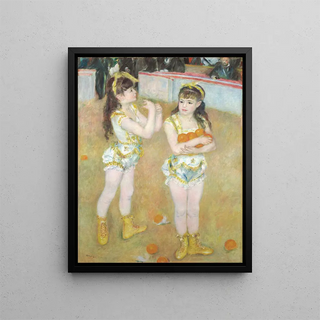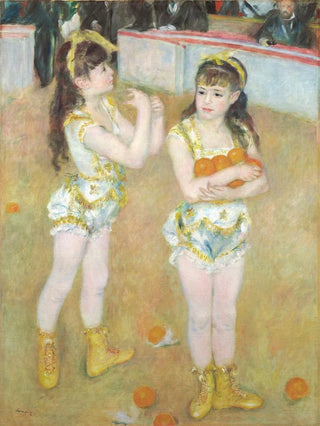Art print | Acrobats at the Fernando Circus Francisca and Angelina Wartenberg - Pierre-Auguste Renoir


View from behind

Frame (optional)
In the vibrant universe of the circus, where the magic of performance meets the brilliance of human emotions, the art print "Acrobats at the Fernando Circus Francisca and Angelina Wartenberg" by Pierre-Auguste Renoir stands as a vivid testament to beauty and grace. This painting, created in 1879, captures a fleeting moment, an aerial dance of two acrobats, Francisca and Angelina, whose silhouettes intertwine in a suspended choreography. Renoir, master impressionist, manages to transcend mere representation to immerse the viewer in an atmosphere of jubilation and wonder. The light, vivid colors, and expressions of the characters invite complete immersion into the circus universe, where every detail tells a story.
Style and uniqueness of the work
The work is distinguished by its characteristic style, blending an impressionist technique with an almost intimate approach. Renoir uses fluid brushstrokes to convey the lightness of moving bodies, while playing with shadows and lights to create striking depth. The faces of the acrobats, imbued with contagious joy, are rendered with such delicacy that they seem almost alive. The color palette chosen by the artist, oscillating between warm tones and cooler shades, evokes the warmth of the circus atmosphere while highlighting the freshness and vitality of the artists. Every element, from the scenery to the costumes, is carefully orchestrated to create a visual harmony that captivates the eye and the mind.
The artist and his influence
Pierre-Auguste Renoir, an emblematic figure of the impressionist movement, has always had a particular interest in depicting everyday life, leisure scenes, and human interactions. His work, at the crossroads of tradition and modernity, has profoundly influenced many artists. By choosing the circus as a subject, Renoir aligns with a process that values spectacle and ephemerality, while paying tribute to the art of entertainment. His innovative approach, which favors light and color over rigid contours, opened the

Matte finish

View from behind

Frame (optional)
In the vibrant universe of the circus, where the magic of performance meets the brilliance of human emotions, the art print "Acrobats at the Fernando Circus Francisca and Angelina Wartenberg" by Pierre-Auguste Renoir stands as a vivid testament to beauty and grace. This painting, created in 1879, captures a fleeting moment, an aerial dance of two acrobats, Francisca and Angelina, whose silhouettes intertwine in a suspended choreography. Renoir, master impressionist, manages to transcend mere representation to immerse the viewer in an atmosphere of jubilation and wonder. The light, vivid colors, and expressions of the characters invite complete immersion into the circus universe, where every detail tells a story.
Style and uniqueness of the work
The work is distinguished by its characteristic style, blending an impressionist technique with an almost intimate approach. Renoir uses fluid brushstrokes to convey the lightness of moving bodies, while playing with shadows and lights to create striking depth. The faces of the acrobats, imbued with contagious joy, are rendered with such delicacy that they seem almost alive. The color palette chosen by the artist, oscillating between warm tones and cooler shades, evokes the warmth of the circus atmosphere while highlighting the freshness and vitality of the artists. Every element, from the scenery to the costumes, is carefully orchestrated to create a visual harmony that captivates the eye and the mind.
The artist and his influence
Pierre-Auguste Renoir, an emblematic figure of the impressionist movement, has always had a particular interest in depicting everyday life, leisure scenes, and human interactions. His work, at the crossroads of tradition and modernity, has profoundly influenced many artists. By choosing the circus as a subject, Renoir aligns with a process that values spectacle and ephemerality, while paying tribute to the art of entertainment. His innovative approach, which favors light and color over rigid contours, opened the






